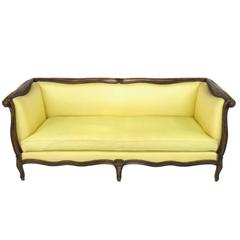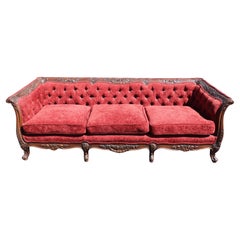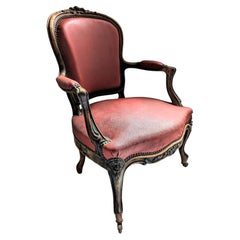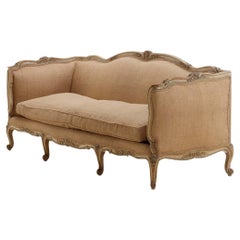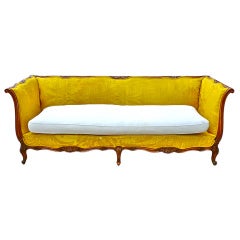Louis Xv Style Even Arm Sofa
Vintage 1970s American Louis XV Canapes
Vintage 1920s French Louis XV Sofas
Walnut
Antique 18th Century French Louis XV Living Room Sets
Beech
Recent Sales
Early 20th Century Louis XV Sofas
Upholstery, Wood
Early 20th Century French Sofas
People Also Browsed
Antique Late 19th Century French Louis XVI Daybeds
Wood
Vintage 1930s French Sofas
Wood
21st Century and Contemporary American Sofas
Linen, Velvet
Vintage 1930s French Art Deco Settees
Velvet, Beech
20th Century Louis XVI Loveseats
Wood
Antique 1840s Indian Regency Sofas
Cane, Rosewood
20th Century French Louis XVI Settees
Fabric, Satin, Silk, Wood
2010s British Louis XVI Sofas
Beech
20th Century French French Provincial Sofas
Velvet, Walnut
Antique 1720s Spanish Baroque Beds and Bed Frames
Giltwood, Paint
1990s American Louis XVI Sofas
Velvet, Wood, Feathers
Vintage 1950s American Louis XV Sofas
Wood, Upholstery
Antique Early 19th Century American Empire Sofas
Upholstery, Walnut, Burl
Antique 18th Century French Louis XVI Sofas
Upholstery, Wood, Down
Antique Mid-18th Century French Louis XV Sofas
Walnut
21st Century and Contemporary American Sofas
Linen
A Close Look at Louis-xv Furniture
The style of 18th-century French furniture was guided by the court. When Louis XV, who reigned from 1715–74, focused royal life on the smaller salons of Versailles rather than its grand chambers, it transformed the aesthetics away from the imposing and angular furniture that characterized the style of Louis XIV. A broader focus on comfort and more delicate forms define antique Louis XV furniture, with nature-inspired carvings, wood inlays, curved cabriole legs, asymmetrical shapes and rounded oval seat backs. The furnishings changed throughout the king’s life, as he ascended to the throne as a child and then grew to establish his own tastes.
Pieces like the bergère, an upholstered armchair with a wide cushion that fit the flowing dresses in fashion at the time, reflected this more informal court. Introduced at the start of Louis XV’s reign, bergère chairs in this style were deeper and broader than other chairs of the period.
Louis XV tapestries and carpets tended to be floral and colorful, and design elements were borrowed from Asia. Dutch-born cabinetmaker Bernard van Risenburgh brought lacquer techniques influenced by Japan and China into his luxuriously made furniture. Along with its fine details, the furniture of the era also featured new innovations including mechanical devices. Jean François Oeben, a royal cabinetmaker, created such intricate pieces as a mechanical table for Madame de Pompadour, Louis XV’s mistress. It involved a sliding top and a writing surface that extended from its marquetry panels.
During the later years of Louis XV’s reign, there was a shift from the ostentatious rocaille style, part of the exuberantly decorative Rococo movement in Europe for which designers such as Nicolas Pineau and Juste-Aurèle Meissonier are known. The style under Louis XVI would return to boxier forms, but with a neoclassical touch inspired by the ancient world.
Find antique Louis XV bedroom furniture, seating, tables and decorative objects on 1stDibs.
Finding the Right Sofas for You
Black leather, silk velvet cushions, breathable bouclé fabric — when shopping for antique or vintage sofas, today’s couch connoisseurs have much to choose from in terms of style and shape. But it wasn’t always thus.
The sofa is typically defined as a long upholstered seat that features a back and arms and is intended for two or more people. While the term “couch” comes from the Old French couche, meaning to lie down, and sofa has Eastern origins, both are forms of divan, a Turkish word that means an elongated cushioned seat. Bench-like seating in Ancient Greece, which was padded with soft blankets, was called klinai. No matter how you spell it, sofa just means comfort, at least it does today.
In the early days of sofa design, upholstery consisted of horsehair or dried moss. Sofas that originated in countries such as France during the 17th century were more integral to decor than they were to comfort. Like most Baroque furnishings from the region, they frequently comprised heavy, gilded mahogany frames and were upholstered in floral Beauvais tapestry. Today, options abound when it comes to style and material, with authentic leather offerings and classy steel settees. Plush, velvet chesterfields represent the platonic ideal of coziness.
Vladimir Kagan’s iconic sofa designs, such as the Crescent and the Serpentine — which, like the sectional sofas of the 1960s created by furniture makers such as Harvey Probber, are quite popular among mid-century modern furniture enthusiasts — showcase the spectrum of style available to modern consumers. Those looking to make a statement can turn to Studio 65’s lip-shaped Bocca sofa, which was inspired by the work of Salvador Dalí. Elsewhere, the furniture of the 1970s evokes an era when experimentation ruled, or at least provided a reason to break the rules. Just about every area of society felt a sudden urge to be wayward, to push boundaries — and buttons. Vintage leather sofas of that decade are characterized by a rare blending of the showy and organic.
With so many options, it’s important to explore and find the perfect furniture for your space. Paying attention to the lines of the cushions as well as the flow from the backrest into the arms is crucial to identifying a cohesive new piece for your home or office.
Fortunately, with styles from every era — and even round sofas — there’s a luxurious piece for every space. Deck out your living room with an Art Deco lounge or go retro with a nostalgic '80s design. No matter your sitting vision, the right piece is waiting for you in the expansive collection of unique sofas on 1stDibs.
